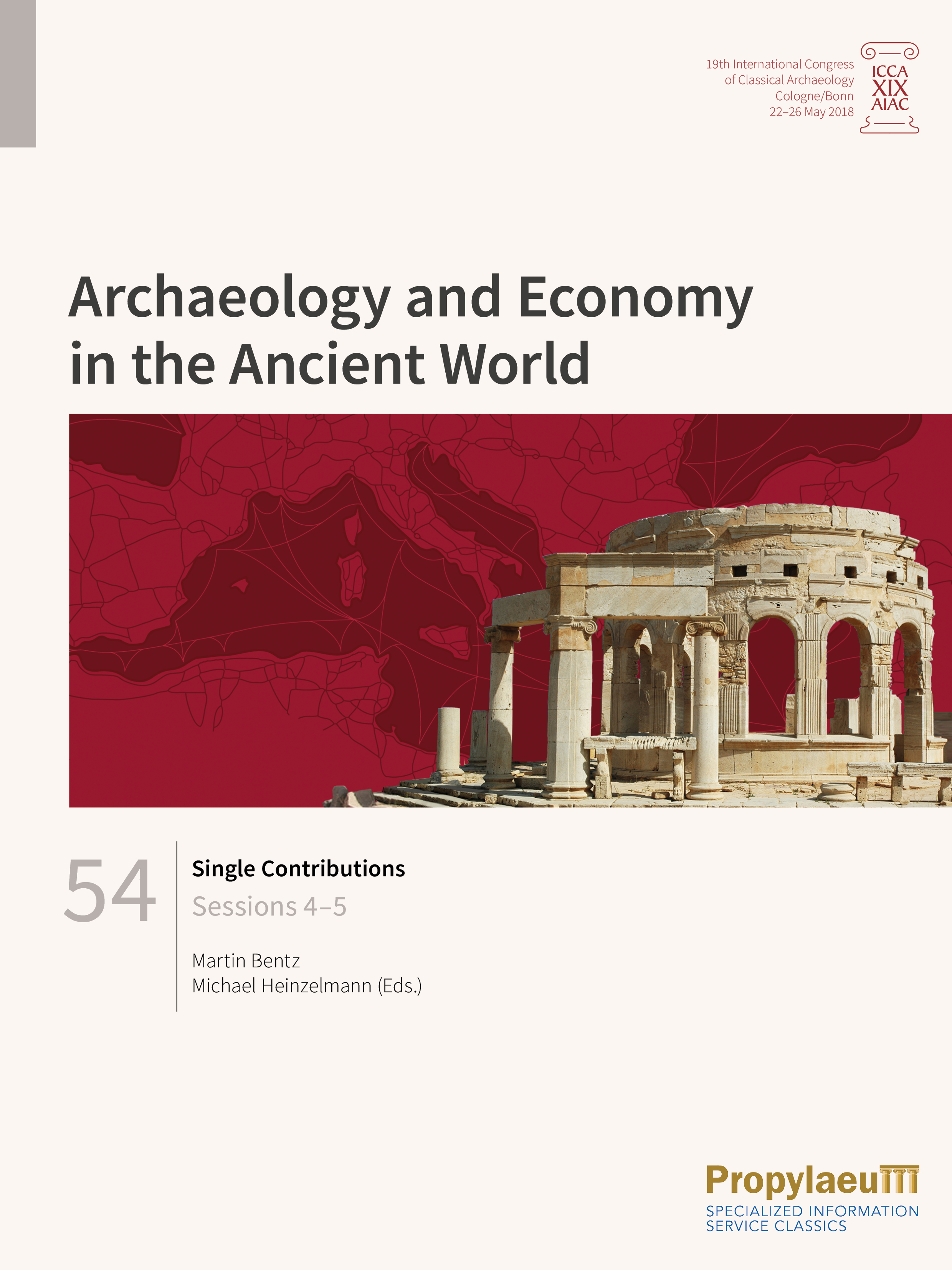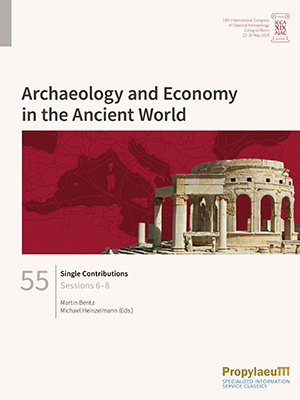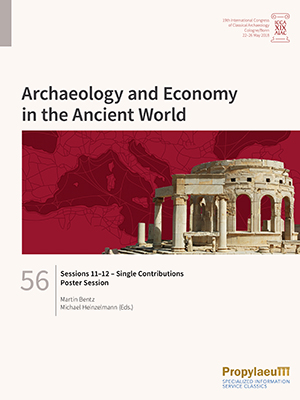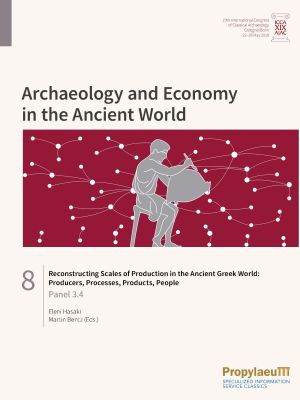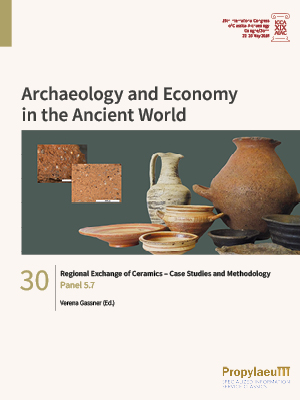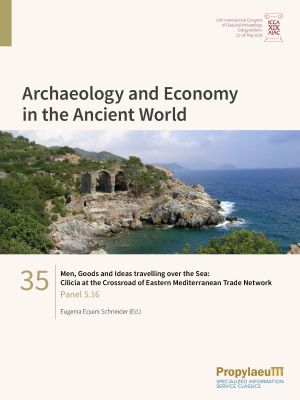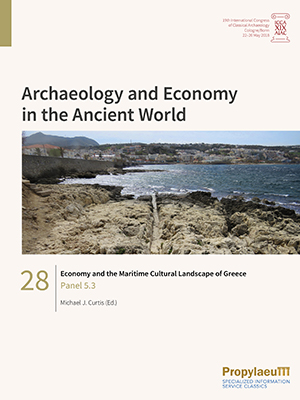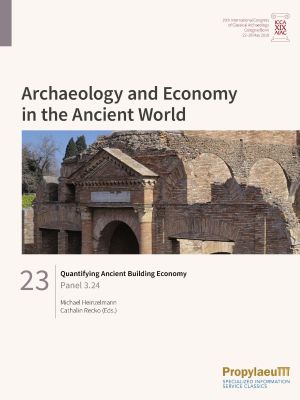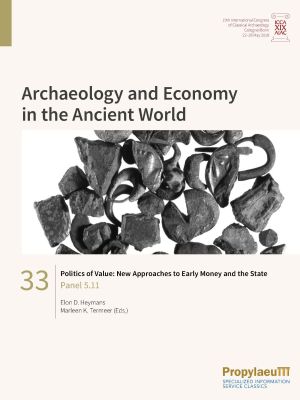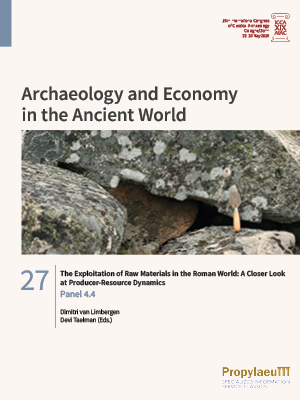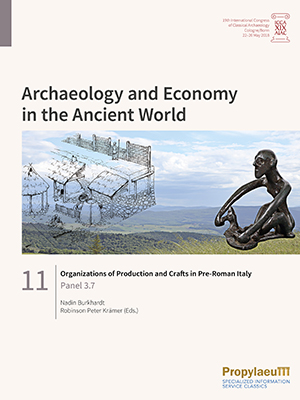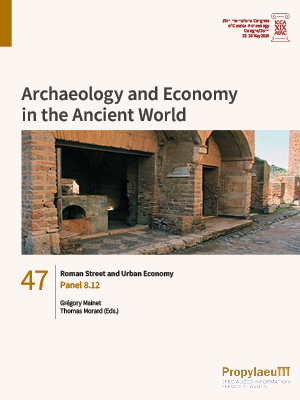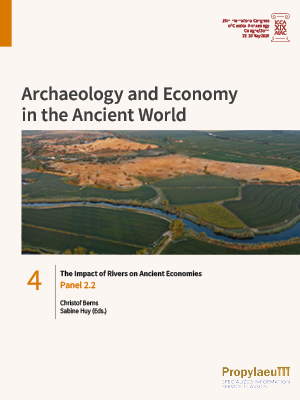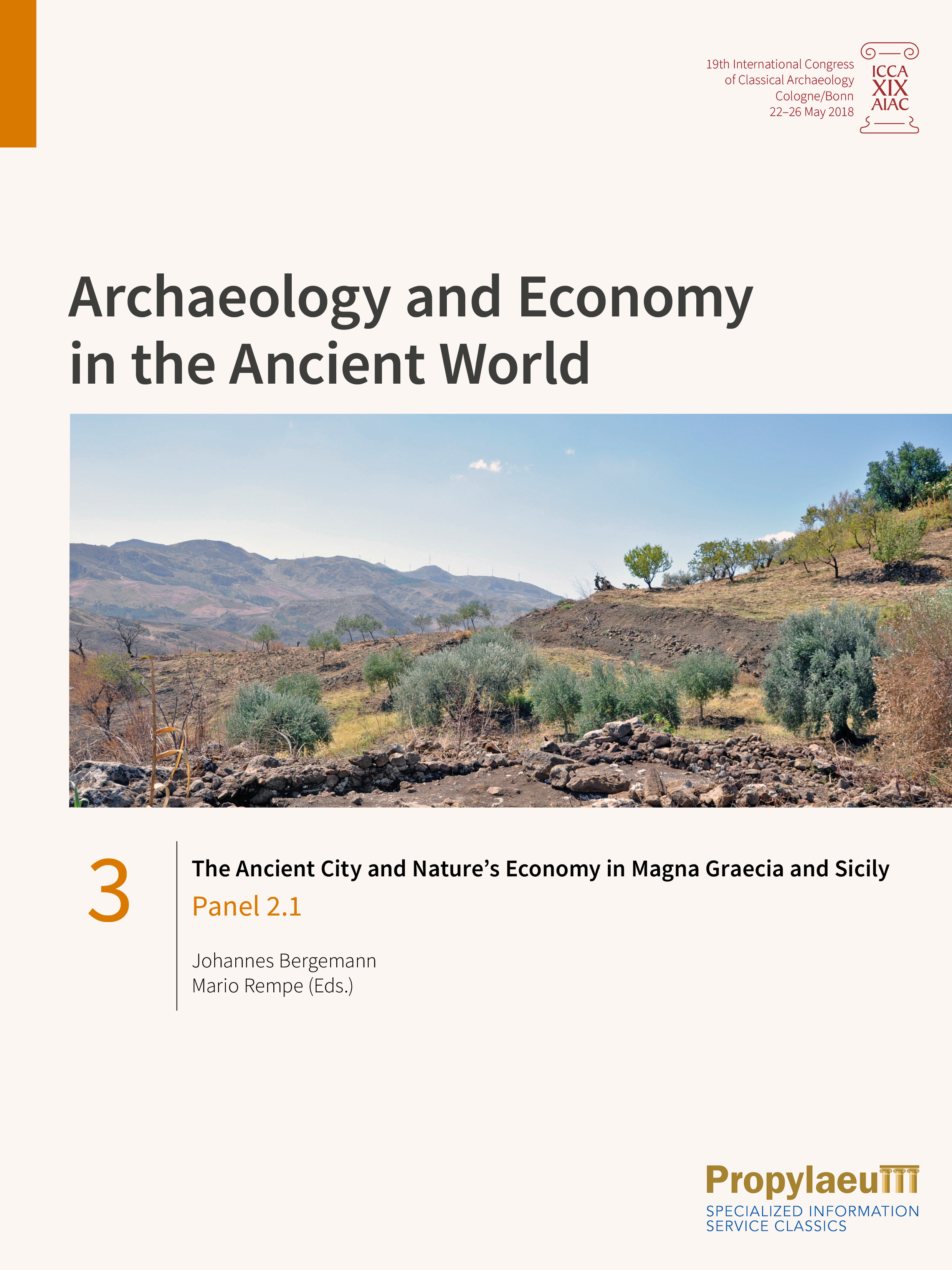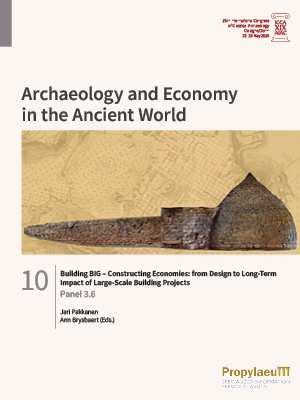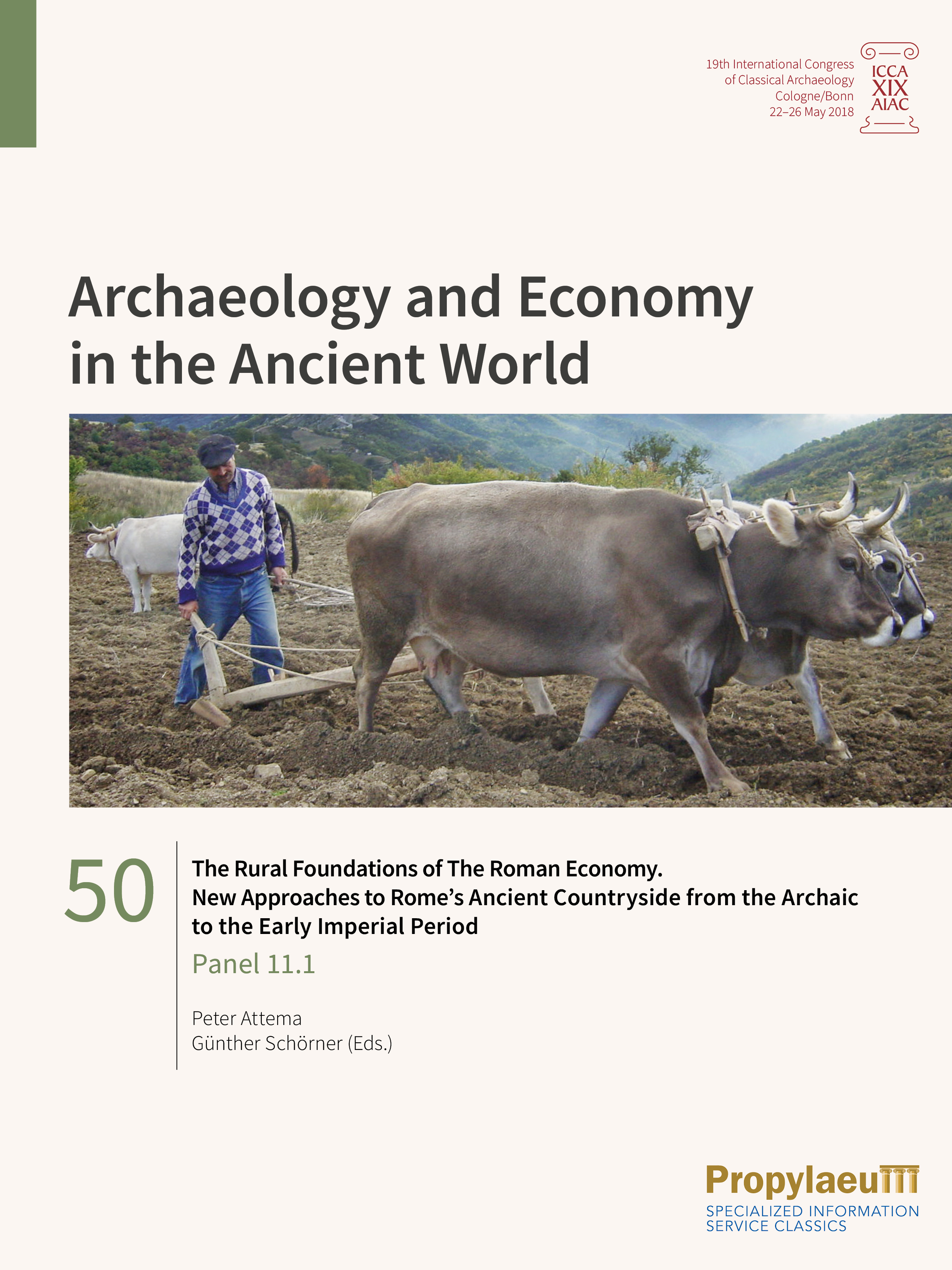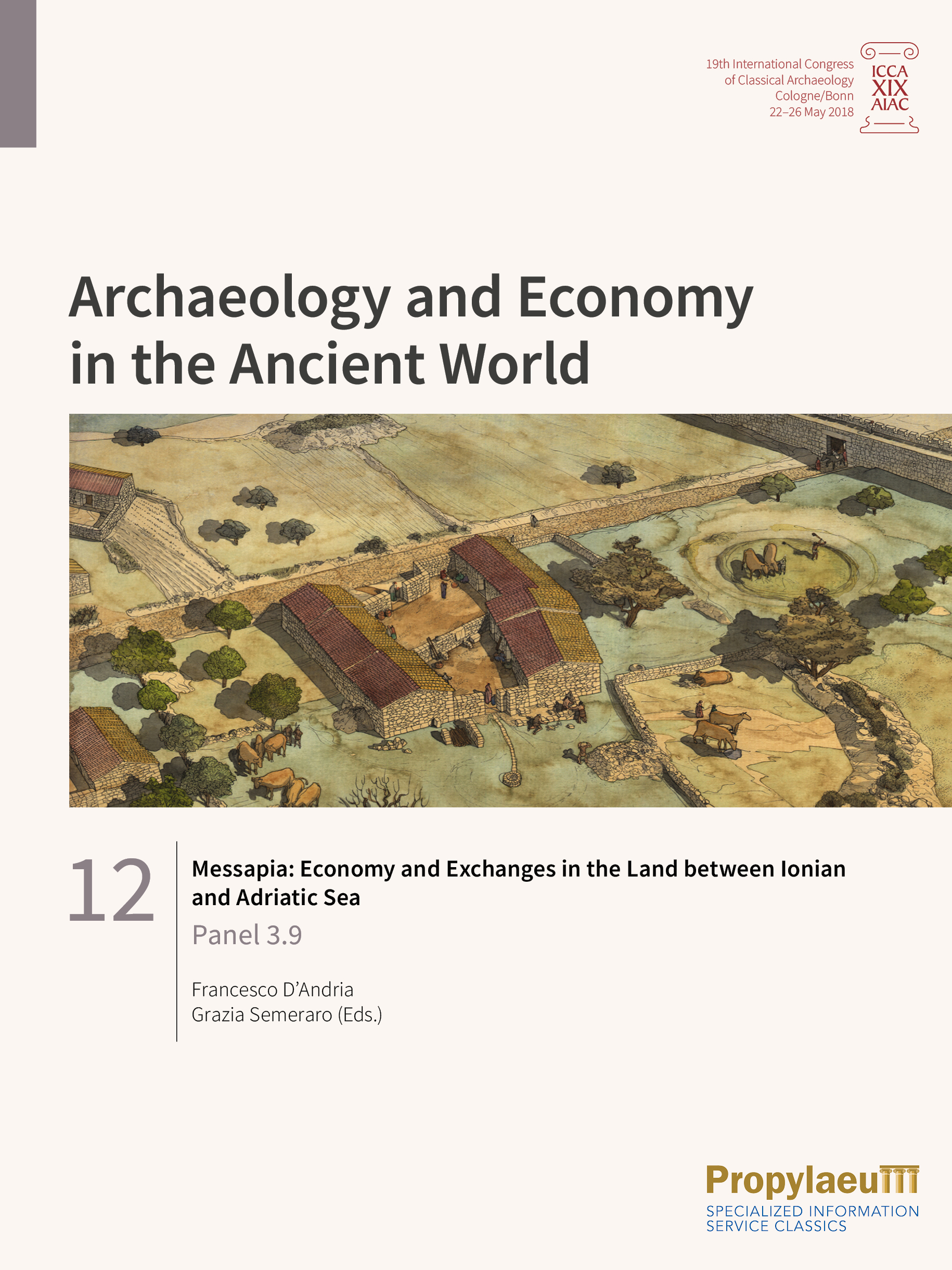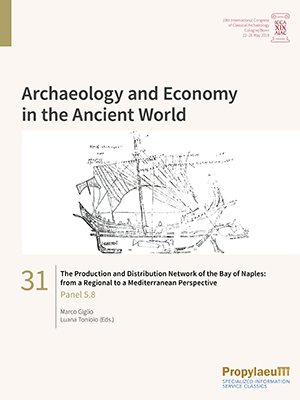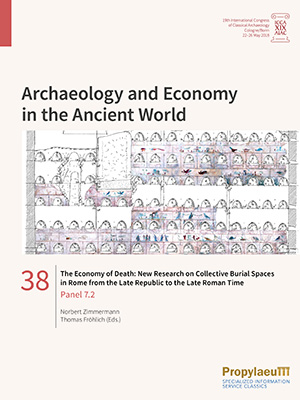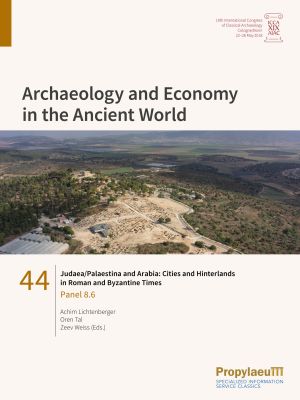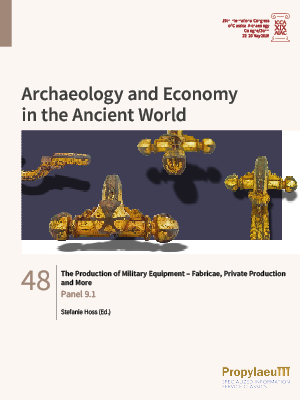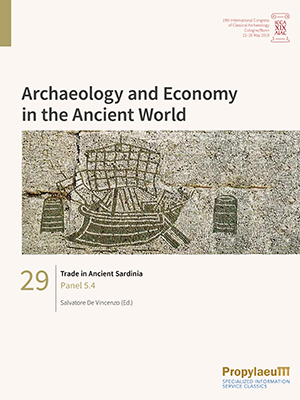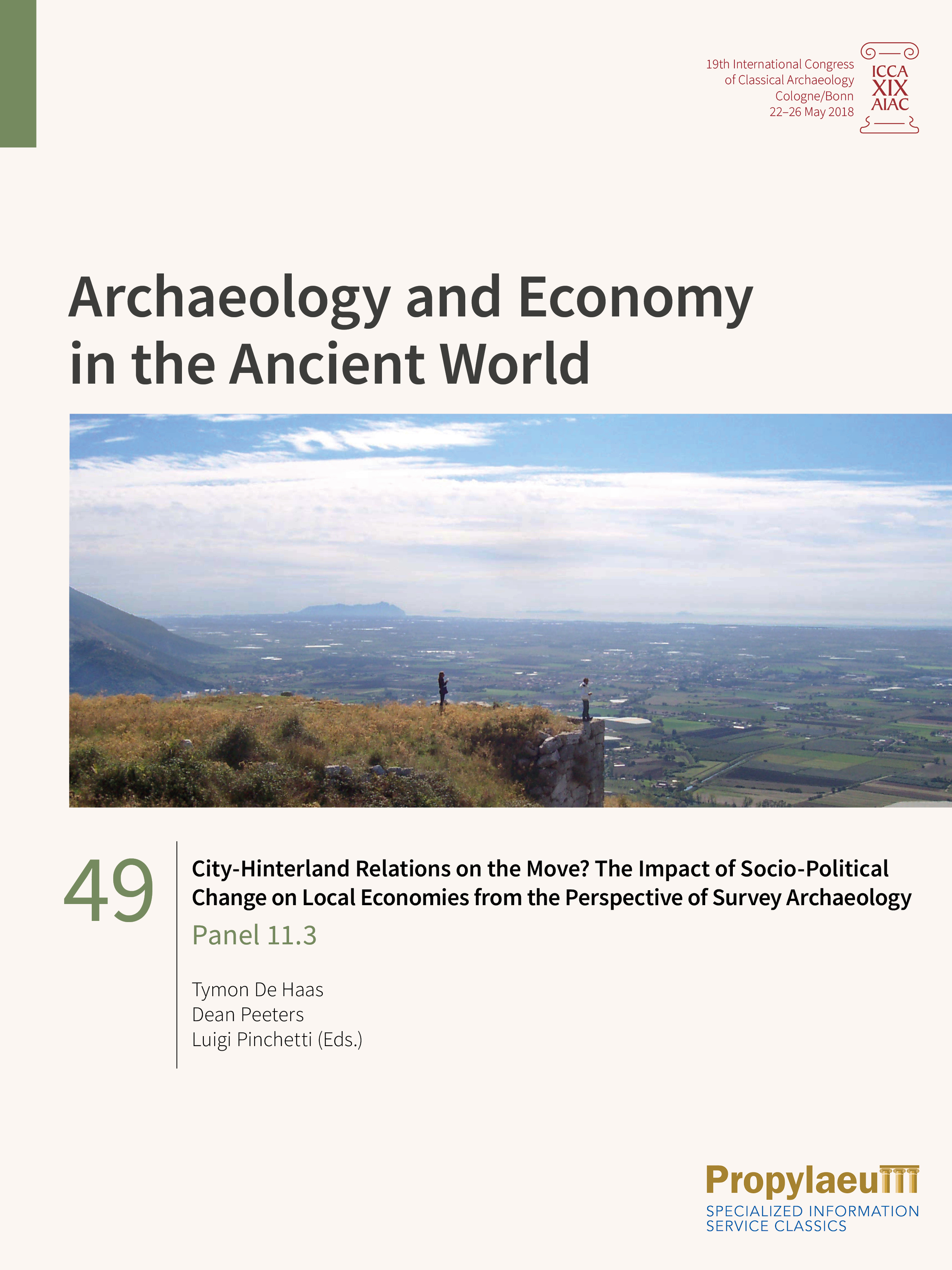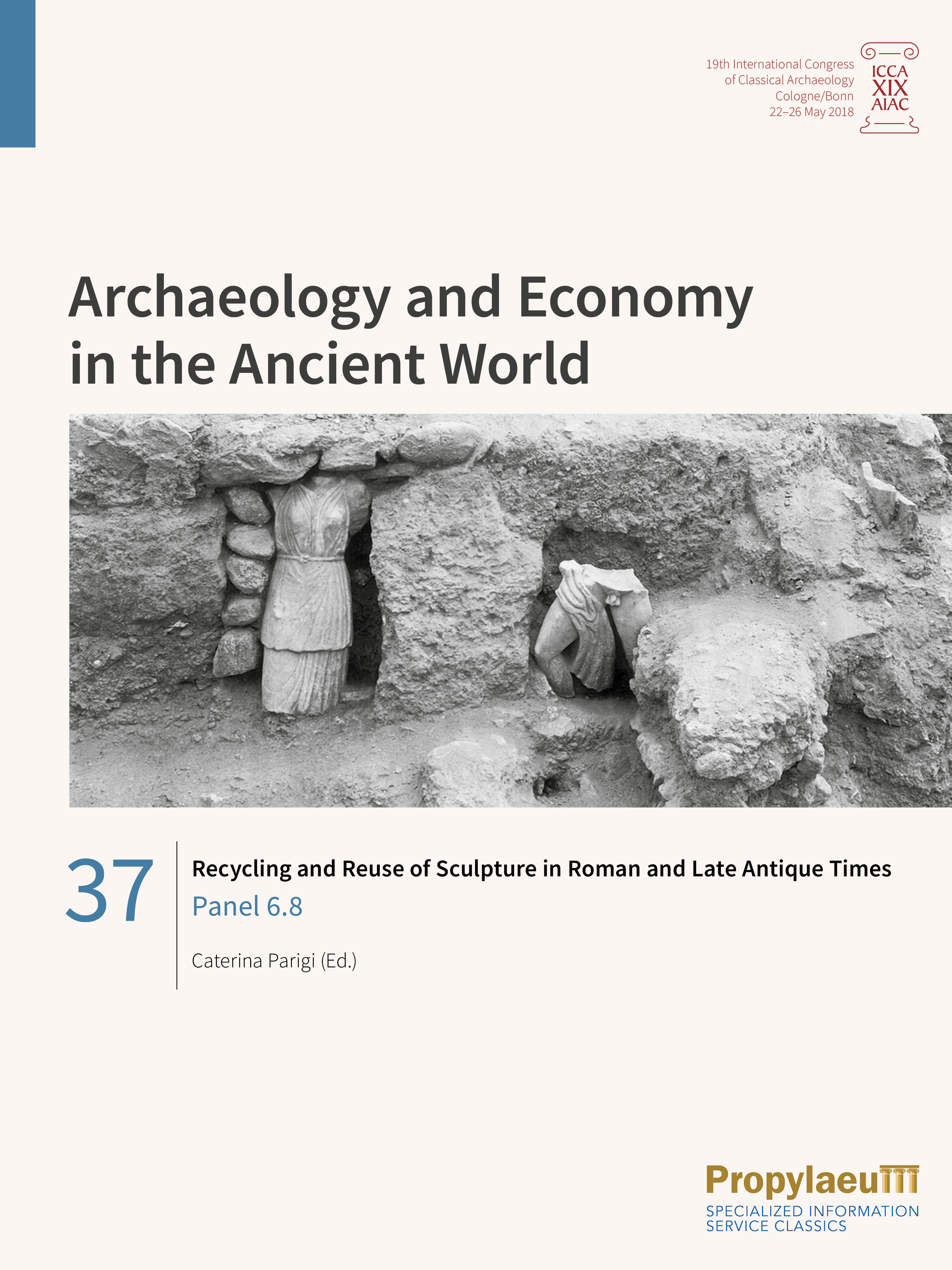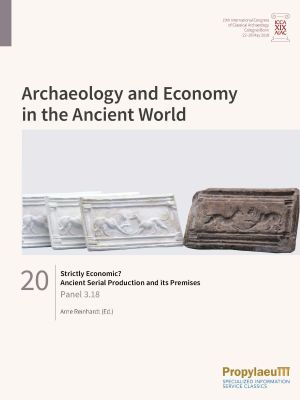Bentz, Martin
Sessions 4–5, Single Contributions
Economic aspects permeate all areas of public and private life in ancient societies, whether in urban development, religion, art, housing, or in death. Research on ancient economies has long played a significant role in ancient history. Increasingly in the last decades, awareness has grown in archaeology that the material culture of ancient societies offers excellent opportunities for studying the structure, performance, and dynamics of ancient economic systems and economic processes. Therefore, the main objective of this congress was to understand economy as a central element of classical societies and to analyse its interaction with ecological, political, social, religious, and cultural backgrounds. The theme of the congress was addressed to all disciplines that deal with Greco-Roman civilization and their neighbouring cultures from the Aegean Bronze Age to the end of Late Antiquity.
In this collective volume, single contributions of sessions 4 and 5 deal with questions on the exploitation of resources such as metals and marble in the Roman imperial period and also on distribution, trade and networks in general in antiquity. Thematically, the studies range from trade and cultural contacts in the Iron Age and Archaic Mediterranean, Greek and Roman coinage, to Roman trade and transport systems.
Sessions 6–8, Single Contributions
Economic aspects permeate all areas of public and private life in ancient societies, whether in urban development, religion, art, housing, or in death. Research on ancient economies has long played a significant role in ancient history. Increasingly in the last decades, awareness has grown in archaeology that the material culture of ancient societies offers excellent opportunities for studying the structure, performance, and dynamics of ancient economic systems and economic processes. Therefore, the main objective of this congress was to understand economy as a central element of classical societies and to analyse its interaction with ecological, political, social, religious, and cultural backgrounds. The theme of the congress was addressed to all disciplines that deal with Greco-Roman civilization and their neighbouring cultures from the Aegean Bronze Age to the end of Late Antiquity.
This collective volume contains single contributions from sessions 6, 7 and 8, which discuss questions about consumption and investment in everyday life, sanctuaries and urban contexts, as well as questions about the role of the city in the ancient economy.
Sessions 11–12, Single Contributions – Poster Sessions
Economic aspects permeate all areas of public and private life in ancient societies, whether in urban development, religion, art, housing, or in death. Research on ancient economies has long played a significant role in ancient history. Increasingly in the last decades, awareness has grown in archaeology that the material culture of ancient societies offers excellent opportunities for studying the structure, performance, and dynamics of ancient economic systems and economic processes. Therefore, the main objective of this congress was to understand economy as a central element of classical societies and to analyse its interaction with ecological, political, social, religious, and cultural backgrounds. The theme of the congress was addressed to all disciplines that deal with Greco-Roman civilization and their neighbouring cultures from the Aegean Bronze Age to the end of Late Antiquity.
In this collective volume, single contributions from sessions 11 and 12 deal with digital topics such as computational approaches and 3D documentation in archaeology and building research. On the other hand, the studies include topics on ancient sculptures and sanctuaries as well as the rituals associated with them.
Furthermore, the numerous transcribed posters which have been presented and discussed during the congress week in the context of a poster session are published in this volume.
Reconstructing Scales of Production in the Ancient Greek World: Producers, Processes, Products, People: Panel 3.4
Scholars have adopted an array of approaches, both traditional and experimental, to approximate the scale of craft production, which has always been central to the study of ancient economies. This panel examines these new methods, for estimating the workshop crew size, the workshop physical space, the time requirements for the chaîne opératoire for each product, the needs of the population for different goods, or the percentage of ancient products surviving to this day. These new approaches, some borrowed from related disciplines, should help us overcome the paucity of archaeological evidence. By employing social network analysis, individual worker’s output, architectural energetics, and production-consumption ratios, we aim to improve our understanding of the scale of craft production in the ancient Greek world, both in the Greek mainland and in the Greek colonies in Sicily. Archaeologists and ancient economists are using new approaches to study the ancient economy at a micro-level, taking into consideration several variables, such as raw material procurement, labor investment, cross-craft dependencies, apprenticeship periods, and product demand, to name a few. From Prehistoric to Classical Greece and Italy, the industries covered are mostly ceramics-centered, such as pottery and tiles, but also pavement construction and funerary monumental architecture.
Regional exchange of ceramics – case studies and methodology: Panel 5.7
Pottery vessels and other ceramic objects constitute important sources for issues of trade and exchange in Antique societies as they are available in great quantities and as their provenance often can be determined by archaeological or archaeometric methods. Most studies on the exchange of ceramics however concentrate on aspects of long-distance trade, as differences between wares and/ or types produced in different, far distant regions can be recognized more easily. This fact, together with the psychological fact of the greater attractiveness of these items, might have lead to an exaggerated perception of the amount of goods traded via the oversea trade in the archaeological record. In contrast to this, aspects of regional exchange between neighbouring cities have not been given the same attention in the field of Mediterranean archaeology, although they might give important insights into the problems of regional connectivity and they also had greater importance during Antiquity than normally assumed. One of the reasons of this deficit can certainly be found in the difficulty of clearly and unambiguously distinguishing ceramics produced within one r egion f rom e ach other, a s t hey o ften s hare the s ame repertory of shapes or decoration styles.
This panel comprises case studies from different areas and different periods of the Mediterranean, all of which clearly demonstrate the difficulties in reconstructing networks of regional exchange, but also show their importance for the economy of ancient towns.
Men, Goods and Ideas Travelling over the Sea. Cilicia at the Crossroad of Eastern Mediterranean Trade Network: Panel 5.16
Thanks to its specific geographical position, at the crossroads of the most important sea and land trading routes, in a necessary point of transition and interconnection between Syria, Cyprus and Egypt, Cilicia has always played a distinctive role within the context of cultural, social and commercial exchanges in the Mediterranean area. In particular during its Romanisation, the commercial relations with the various areas of the Empire were of fundamental importance, and particularly the relations with the Eastern Mediterranean, which were substantial, and were constantly maintained until the first Byzantine age. The subject of this panel was an assessment of the present knowledge on this region, focusing on integrated studies on production exchanges, trade and transport in the Mediterranean. Underwater research, archaeological and geophysical investigation about harbour basins, the study of production facilities, analysis of material culture and numismatic evidence have led and are still leading to an exhaustive picture of the changes and transformations involving the region and the urban centres throughout centuries as a result of evolving large-scale economic and social processes. The resulting large amount of information about the role played by the region as a production centre and a market-place has created comparative samples for other research under way in Cilicia and south-eastern Turkey.
Economy and the Maritime Cultural Landscape of Greece: Panel 5.3
In recent years new research and investigation along the coastlines has added to our understanding of the maritime cultures and traditions of ancient Greece. Even so, the maritime cultures, traditions and social aspects remain understudied and the traditional boundaries between terrestrial and underwater archaeology are still problematic and a challenge to researchers. Throughout time the settlements that stood beside the sea became increasingly important to local and regional economies, as they often benefitted from local, inter-island and cross-Mediterranean trade and the commercial and networking opportunities that this offered. Many of these settlements were the first point of contact for seafarers, travellers, and migrants, playing an important role in the diffusion of cultural, political, and religious ideologies.
The papers in this volume take us on a journey in time from an Early Bronze Age settlement on Paros to the Closed Harbours of Archaic and Classical Greece, and on to life in Hellenistic and Roman Crete. Whilst being preliminary perspectives, the contributions in this volume demonstrate the broad variance in subject material and offer an interesting insight into the world of maritime Greece.
Quantifying Ancient Building Economy: Panel 3.24
In recent years, the study of ancient construction has focused increasingly on putting the different aspects of the process of building into an economic framework. This entailed examining the various steps of construction and the organization of a building site in detail. It also meant that attempts were made to quantify the use of both the materials and the labour necessary for the building project, as these illustrate the scale of a building project and its impact on the overall economy.
The goal of this volume is to bring together different approaches of the study of the economy of building. With the help of methods of quantification and intensive architectural studies, the case studies of city walls, baths, temples and timber buildings in this volume not only shed light on the various constructional characteristics of these buildings, but also on a wide range of economic implications. The collection of papers ranges from Messene in the 4th century BC to Imperial Rome and are completed by practical insights from 19th century building manuals.
Politics of Value: New Approaches to Early Money and the State: Panel 5.11
As one of the most enduring icons of economic life, money has been a common feature and central focus in complex societies from Antiquity to the present. It gained weight as a key feature of Mediterranean economies in the course of the first millennium BCE, mostly in the form of coinage. But money is more than just coin, and its significance is more pervasive than just to the strict sphere of “the economy”.
In the ancient Mediterranean, money and its rise to prominence have b een p redominantly a ssociated w ith t he s tate. B ut c an money only emerge under state authority? This volume questions the assumed relation between the spread of early forms of money and the state and draws attention to different ways in which money as an innovation could be anchored and socially embedded.
The Exploitation of Raw Materials in the Roman World: A Closer Look at Producer-Resource Dynamics: Panel 4.4
Compared to other pre-modern economies, the Roman world stands out for having developed a highly specialised and very productive manufacturing sector. This development led to the widespread and large-scale extraction of raw materials. Even in a territory as large as the Roman Empire, such activities put major
pressure on the land. Strategies of resource exploitation and conservation were thus essential in dealing successfully with the limited availability of these resources in the medium or long term, and to ensure the sustainability of the Roman exploitation model. This volume deals with the various ways in which natural resources were exploited and managed in the Roman world. It focuses on if, when, where and how the Romans pursued a harmonious balance between the limited availability of a particular resource and the law of supply and demand. The case studies in this volume cover various key areas of the Western Roman world – from Italy and the island of Elba, over coastal Croatia to Central-Eastern Gaul and the Pannonian limes – and discuss in particular the fi sh industry, iron smelting, deforestation and forest management, the stone trade and the exploitation of thermo-mineral resources.
Organizations of Production and Crafts in Pre-Roman Italy: Panel 3.7
While economic approaches are becoming generally more important and even mainstream topics, this is not necessarily the case for research into Pre-Roman Italy, defined as the area of the Italian Peninsula, Sicily and Sardinia during the Iron Age. Until recently, there was almost no research into Pre-Roman Italy focused on economic studies, and the existing research has been mostly dedicated to very specific contexts:
(1) specialization of crafts and production in the context of urbanization processes; (2) specific production areas, such as agriculture, metal processing, and salt production; (3) studies focusing on Greek Colonies and Greek Colonial encounters with indigenous populations; (4) analyses of consumption patterns, mainly in the case of Greek pottery consumption. Recent excavations and investigations devoted to the study of workshop structures, such as those at Gabii, Pithekoussai, Kroton, Lokroi Epizephyrioi, Naxos, Selinunt and Kyme / Cumae, have provided a range of new data that is stimulating a valuable and highly constructive discussion on the organization of production and crafts in Pre-Roman Italy. Against this background, four members of the study group ‘Etruscans and Italic Cultures’ from the ‘German Association of Archaeologists’ (Arbeitsgemeinschaft Etrusker und Italiker des DArV e.V.) formed a panel to discuss the economic aspects of Pre-Roman Italy on the basis of their ongoing research projects: all of these focus on the field of production and crafts. The aim is to contribute to an intensified debate on geographical, chronological and functional patterns in the organization of crafts and productions by discussing current case studies and methods.
Roman Street and Urban Economy: Panel 8.12
Streets played a key role in shaping the ancient economic townscape. We usually consider streets simply as a thoroughfares for traffic, but this idea falls short of the facts as suggested by ancient authors like Martial or Juvenal. The “street space” was built in three dimensions and was an important place for the social and economic interactions constituting the urban social life in Antiquity. Such a function clearly appears in the architecture of the street shaped by numerous tabernae built within atrium houses, rows of shops or multi-storey buildings and by the activities which happened there. In other words, the economy of ancient cities was not confined to specific buildings such as macella.
On the contrary, economic activities extended beyond the walls of such buildings and invaded the whole urban fabric along the streets. The papers of the panel “Ancient Streets and Urban Economy” intend to shed new light on the role of the space of the street in the urban economy in ancient societies between the 2 nd century BC and the 3 rd century AD in particular. To further our understanding, the different authors propose to examine some case studies from for instances Alba Fucens, Athens, Lugdunum, Norba, Ostia and Pompeii.
The Impact of Rivers on Ancient Economies: Panel 2.2
The increased interest in the mutual interdependence of socio-cultural and physical spaces has led to the fact that watercourses have gained in importance as a formative factor of societies. Landscapes shaped by rivers provide characteristics and specific conditions that have a major impact on the economic life of people living in riverine contexts. Rivers are significant natural resources and offer special opportunities for economic activities. They can act both as connecting arteries and as borderlines. The contributions of our panel describe rivers as dynamic factors of ancient communities and their economy. The articles presented in this volume focus on the interrelation between river landscapes and the economic habits of their inhabitants. The case studies cover a wide range of epochs and geographical areas and discuss phenomena such as geomorphic and anthropogenic changes in rivers, the role of rivers as transport and trade routes and their impact on settlement patterns.
The Ancient City and Nature's Economy in Magna Graecia and Sicily: Panel 2.1
The panel offered archaeological landscape studies and paleoenvironmental reconstructions, thus shedding light on human-environment interactions. Archaeological research combined with Earth Sciences made different patterns of these interactions visible at several sites in Magna Graecia and Sicily.
Approaches combined archaeological methods with Geoarchaeology, Palynology, Zooarchaeology, and Climate History. The case studies covered a long period, reaching back to the early phases of Greek settlement on Sicily. Moreover, shifts in settlement dynamics between Roman and Greek times were observed and hypotheses created by taking a paleoenvironmental perspective. At the same time, economic and social implications and their effects on the data were considered. Examples originated from survey archaeology as well as from samples gained during excavations.
Building BIG – Constructing Economies: from Design to Long-Term Impact of Large-Scale Building Projects: Panel 3.6
This volume contains various studies that range from prehistoric Greek building programmes to building in the Roman period. The economic growth of modern societies has been closely linked with construction industries: investments, transport infrastructures for materials and labour-intensive building programmes all have a large impact on local, regional and even global economies. The end results have shaped the built environment of our everyday lives and have often led to an increased quality of life and affluence, though there are many cases that did the opposite as well. Large-scale building projects in pre-industrial societies required extensive manual labour to be invested from the moment materials were scouted for, over the extraction, transportation, use and the subsequent maintenance. Since most ancient societies were based on subsistence economies, important decision-making was a daily balancing act between building work and agriculture. These decisions often strongly influenced the patterns of land use and may have also resulted in circular economic strategies. The papers presented in this volume emphasise the importance of the socio-economic and political structures and decision-making that resulted in ‘Building Big’, irrespective of the shape and final size of the projects.
The Rural Foundations of The Roman Economy. New Approaches to Rome’s Ancient Countryside from the Archaic to the Early Imperial Period: Panel 11.1
The aim of the AIAC 2018 session “The Rural Foundations of the Roman Economy, new approaches to Rome's ancient countryside from the Archaic to the Early Imperial period” was to bring together methodologically informed, data-driven studies to shed light on the drivers and performance of the Central Italian rural economy during the Archaic to Imperial periods. The session resulted in a coherent collection of papers by a broad range of international scholars in the field who approach the Roman agricultural economy from various disciplinary angles and at different scales. The collection has a sharp focus on the suburbium of Rome sensu lato. Topics range from rural settlement dispersal, economic and demographic modelling to survey artefact analysis and the study of pollen and plant macro-remains.
Messapia: Economy and Exchanges in the Land between Ionian and Adriatic Sea: Panel 3.9
Ever since the Bronze Age, the geographical position of Messapia, between the Ionian and Adriatic seas, has enabled the development of relations characterised by continuity within the framework of mobility in the Mediterranean. This volume focuses on certain aspects of the economy in Messapia, with particular reference to bio-archaeological themes (including livestock rearing and the consumption of animal resources), textile production (applying archaeometric methods to residues of fabric) and imports of luxury products from Greek cities and the Greek colonies of southern Italy. The presence in grave goods of imported prestige items has been investigated with reference to the forms of self-representation adopted by the Messapian aristocracy in both funerary rituals and manifestations of power within the settlements. The variety of religious manifestations in the Messapian world constitutes a particular case study linked to cultural exchanges, which, thanks to the recent discoveries of places of worship, can now be investigated in detail. Important in this regard are the discoveries made in Castro, where the Athenaion – linked to the myth of Aeneas’s first landing on the shores of Italy – was identified.
The Production and Distribution Network of the Bay of Naples: from a Regional to a Mediterranean Perspective: Panel 5.8
Recent excavations on both production and consumption sites in Campania and international conferences on Roman pottery have given new impulses to the research on material culture and the regional and international pottery trade systems.
This volume analyses the circulation of pottery produced in the Bay of Naples between the late Republican and the early Imperial period from a double perspective: on one side the networks that transported pottery from the Bay to various points along the Mediterranean littoral; and on the other side the foods coming to Naples from various points in the Mediterranean.
The excavation contexts of Piazza Municipio in Naples, Puteoli and Herculaneum provide new relevant datasets both from the qualitative and quantitative point of view. This evidence highlights the strong relations of this area with the Eastern Mediterranean, especially in fine wares and transport containers - from the 2nd century BC Rhodian wine amphorai to 1st century AD Cretan products.
The area of the Magdalensberg imported Campanian Internal Red Slip ware as early as the late Republican period, and in especially high amounts in the Augustan age, when Campanian cooking wares are also attested in Aquileia, in northern Italy, the hotspot for the distribution of these vessels to the provinces of Northern Europe.
The Economy of Death: New Research on Collective Burial Spaces in Rome from the Late Republic to the Late Roman Time: Panel 7.2
The contributions of this volume study economic aspects of Roman burial architectures for extended numbers of burials, such as columbaria, large hypogea, or catacombs, and try to form a picture of their owners and users. They discuss how far economic reasons played a leading role in the invention, the development and the use of these big burial monuments in Rome and how these buildings fulfilled the religious and social needs of their users, especially in the transitional period from the Roman to the Early Christian period. New studies in Roman funeral monuments could document interesting evidence for the dynamic process of the preparation and use of burial space. Especially in larger architectures for much more than a single family, the economic aspects of the ownership and use of these installations is fascinating. Who were the planners of the projects, why were certain places and specific architectures chosen? How and at what time in the project were the burials of the owners and their families provided for? In what manner were further tombs sold or given to others? And which locations within the installation were they able to get? During the last decades, a series of general studies on Roman burials and burial customs were base on older documentation out of necessity, while new and more detailed analysis of single monuments often provide new and different insights of interpretation."
Judaea/Palaestina and Arabia: Cities and Hinterlands in Roman and Byzantine Times: Panel 8.6
While already for several decades, survey archaeology and the investigationof city – hinterland relations have been in the focus of Mediterranean archaeology, the systematic implementation of this method in the southern Levant, is not commonly practiced. Only a few cities in this region were investigated by systematic intensive or extensive field surveys. This volume is dedicated to urban infrastructure and it aims at exploring the relationships between cities and their urban peripheries and hinterlands. It focusses on some southern Levantine major and secondary administrative centers of Judaea/Palaestina and Arabia under Roman and Byzantine rule (1st to 7th century CE). While investigating the historical geography of the southern Levant has a long tradition, today research questions have changed, and in many cases the study of micro-regions with their hinterlands are the focus of field projects. Such studies can only be undertaken in a systematic way, using multi-disciplinary approaches and high-resolution analyses looking at all kinds of zones of urban settlements and connections within the site and its periphery and hinterland. The contributions of this volume present a first attempt to look at urban settlements in the southern Levant from a comparative perspective.
The Production of Military Equipment – Fabricae, Private Production and More: Panel 9.1
The production of military equipment is a subject that is much more complicated than often thought as Roman soldiers were not completely equipped by the state in an uniform manner. While a certain amount of ‘near-uniformity’ was necessary in the army, it was logistically impossible to ensure complete uniformity, even within a single unit. One reason for this was that Roman soldiers owned most of the equipment themselves, which allowed them to choose their own preferences (within limits).
After an introduction and overview of the subject, the three case studies look at what the tools found in a fort can say about the production of military equipment on the site, at the influence of workshop traditions on the making of mail armour and at whether state control or local production was the main impetus in the production of crossbow brooches.
Trade in Ancient Sardinia: Panel 5.4
The themes of this panel are the modes of trade in ancient Sardinia. What are the trade routes touching ancient Sardinia? Which areas and cities in Sardinia were most involved in these exchanges? Which products were exchanged and how was the island's production affected by trade? Which patterns are observable in importing and imitating foreign goods, which were carried to the island by traders? How do these aspects change over time, from Archaic times to Late Antiquity?
This analysis on ancient trade in Sardinia will be carried out predominantly based on pottery contexts. But of course, other trade goods like iron ore, of which Sardinia possessed great amounts, thereby shaping trade routes from the first millennium BC onwards, will be taken into account as well. The chronological phases in question range from Archaic times to Late Antiquity, comprising transactions of indigenous people, Carthaginians, and Greeks, with particular regard to the trade in the Roman era.
City-Hinterland Relations on the Move? The Impact of Socio-Political Change on Local Economies from the Perspective of Survey Archaeology: Panel 11.3
While the impact of major societal transformations on town and country has always been a central topic in field survey archaeology, recent methodological and theoretical advances are offering novel perspectives on this subject. Increasingly intensive field walking techniques, artefact collection strategies and both typological and technological artefact studies have transformed our understanding of rural settlements and ceramic consumption, especially of local (coarse) wares. These developments enable us to study changes in local systems of production and exchange with much more spatial and chronological detail, and in turn contribute to a revision of the impact that large-scale transformations had on local settlement systems and economies.
The papers in this volume explore how survey archaeology can refine our understanding of the links between socio-political change and local economic landscapes. Focusing on different micro-regions in Italy and Greece, the papers present new work that combines archaeological field surveys and ceramic research. Using both tested and novel methodologies, they explore socio-economic change (in consumer practices, systems of agricultural and artisanal production, exchange networks) in the context of the development of the Greek polis, of Roman expansion in different parts of Italy, and of the transformation of Late Antique (local) landscapes in Italy and Greece.
Recycling and Reuse of Sculpture in Roman and Late Antique Times: Panel 6.8
Recycling and reuse of sculpture was a common practice in the ancient world, which took a variety of forms in different periods and places.
The volume stresses two main aspects in relationship to this practice, namely the reuse of sculptures and their parts as building material on the one hand and in their original function or as works of art on the other hand.
The reuse of sculpture has a number of socio-economical aspects. As the economic factor always plays an important role in recycling, it must always be taken into account. It is also important to remember the difficulty to purchase new sculptures in Late Antiquity. However, reuse and recycling are complex processes, which do not have a single cause and not only occur in Late Antiquity. The reuse of statues may also have had an aesthetic value and been seen as a reminder of former times of glory.
This volume focuses on the Roman and Late Antique periods, aiming to show the continuity and the complexity of the phenomenon. Through the comparison of different case studies in varying contexts, the papers highlight the common features and local singularities of this practice.
Strictly Economic? Ancient Serial Production and its Premises: Panel 3.18
The complex subject of production and consumption in antiquity has been attracting growing interest in Classical Archaeology for some time. Research with an economic perspective, such as the investigation of the dynamics of the production of objects or ornaments in Antiquity, has opened up new insights into Greco-Roman culture. Against this background, the present volume focuses on a particular method of production: serial production. On the basis of close-up observations of the finds, the authors of the volume illuminate the broad spectrum of ancient serial production in Greece and Rome in exemplary fashion; the examples deal with a range from (late) Classical ceramics with painted decoration to mechanically reproduced coins and relief tableware to luxurious marble urns. The aim is first describing individual series and defining them and subsequently using this information to interpret the respective conditions that led to the series. This process demonstrates that the phenomenon of serial production (and seriality more generally) consistently transcends economic aspects and seamlessly leads over into other areas of ancient cultural history and its research.



